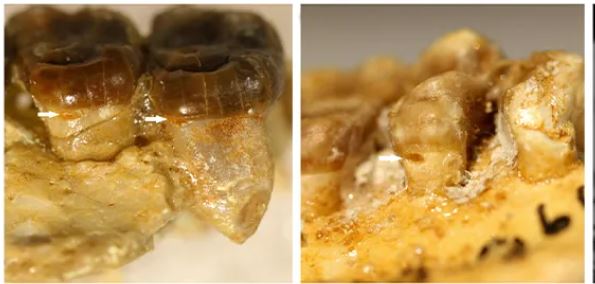Ancient Primate Diets
An intriguing analysis of fossilized primate teeth from the Fayum Depression, a desert basin in Egypt, sheds new light on the dietary habits of ancient primates. Researchers found that these early primates, which lived around 29 to 35 million years ago, predominantly consumed soft foods like fruits, rather than hard objects like seeds or nuts. This discovery provides a deeper understanding of our own evolutionary dietary changes.
Evidence from Fayum Depression
An extensive study of over 400 fossilized primate teeth revealed that only a small fraction exhibited fractures. This analysis, reported in the American Journal of Biological Anthropology, indicates that these primates had diets primarily composed of easy-to-chew foods. The teeth examined belonged to five genera, including Propliopithecus, Apidium, and Aegyptopithecus. These fossils date back to a time when the last common ancestor of apes, including humans, and African and Asian monkeys existed.
Insights from Dental Analysis
Ian Towle, a dental anthropologist at the Centro Nacional de Investigación sobre la Evolución Humana in Burgos, Spain, and his colleagues undertook the meticulous task of examining these ancient teeth. By scrutinizing dental damage that could have been caused by dietary habits, Towle’s team gained valuable insights into the evolution of primate diets. The researchers found that just 21 out of the more than 400 teeth were chipped, placing these primates at the low end of the spectrum compared to living primates.
Comparing Ancient and Modern Primates
The prevalence of chipped teeth among living primates varies widely, from 4% to 40%, depending on their diets. For example, forest-dwelling monkeys like the sooty mangabey, which regularly consume hard foods, often have fractures on up to half of their teeth. In contrast, species like chimpanzees, which primarily eat soft foods such as insects and fruit, show less than 10% chipped teeth. The low incidence of dental fractures in the ancient primates studied suggests a similar dietary pattern dominated by soft foods.
Presence of Cavities
Further evidence supporting the fruity diet hypothesis came from the discovery of cavities in the teeth of two Propliopithecus individuals. Cavities are indicative of a diet rich in sugary foods, likely sweet fruits. This aligns with other studies suggesting that fruit was a significant part of the diet early in the evolutionary history of monkeys and apes.
Discrepancies in Dietary Evidence
While the study strongly suggests a fruit-based diet for these ancient primates, there are still some discrepancies. Previous research analyzing tooth shape and wear patterns has suggested that some species, like Apidium and Aegyptopithecus, may have consumed harder items. Tooth shape can indicate whether a primate’s diet was leaf-based or fruit-based, while microscopic wear patterns reveal what an animal ate in its final weeks or months of life. In contrast, dental chipping provides a longer-term dietary record, potentially lasting years or decades before becoming visibly worn away.
Future Research Directions
Towle acknowledges that the differences between these methods pose a challenge. “At the moment, we really don’t know why different methods are coming up with different results,” he says. He emphasizes the importance of using multiple techniques to piece together a comprehensive picture of ancient diets. The possibility exists that these primates consumed fruit while their teeth, seemingly adapted for harder foods, served an unknown function or had features making them less prone to chipping.
Evolutionary Implications
This study’s findings offer significant implications for understanding the dietary evolution of primates, including humans. By examining the dental records of these ancient creatures, researchers can trace changes in diet that may have influenced various aspects of primate evolution, from physical adaptations to social behaviors. The preference for soft foods like fruit suggests that early primates might have had access to plentiful fruit resources, which could have impacted their development and evolutionary trajectory.
Conclusion: Revisiting Primate Evolution
The discovery of unchipped teeth in ancient primates from the Fayum Depression offers a fascinating glimpse into the dietary habits of our distant relatives. By focusing on the soft, fruity components of their diet, these primates avoided the dental damage associated with harder foods. This research not only enhances our understanding of primate evolution but also underscores the importance of integrating multiple lines of evidence to uncover the complexities of ancient diets. As scientists continue to explore these intriguing findings, they will undoubtedly contribute to a richer understanding of our evolutionary history.
Summary Table
| Key Learning Points |
|---|
| Ancient primates predominantly consumed soft foods like fruits. |
| Analysis of over 400 fossilized teeth revealed minimal fractures. |
| Only 5% of the teeth were chipped, suggesting a soft-food diet. |
| Cavities found in two Propliopithecus individuals indicate sugary foods. |
| Discrepancies exist between tooth shape, wear patterns, and chipping. |
| The study provides insights into the evolution of primate diets. |
| Further research is needed to reconcile different dietary evidence. |

Sunil Garnayak is an expert in Indian news with extensive knowledge of the nation’s political, social, and economic landscape and international relations. With years of experience in journalism, Sunil delivers in-depth analysis and accurate reporting that keeps readers informed about the latest developments in India. His commitment to factual accuracy and nuanced storytelling ensures that his articles provide valuable insights into the country’s most pressing issues.



